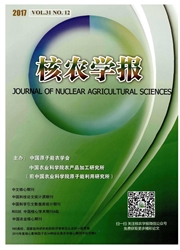

 中文摘要:
中文摘要:
为研究清酒乳杆菌固态发酵鳓鱼过程中品质的变化,以促进传统发酵水产品标准化生产中品质控制水平的提高,本研究综合测定了鳓鱼发酵过程中的理化、色度和质构等常规指标,采用电子舌技术对滋味特性进行分析,对感官品质进行了人工评价,并对各指标之间的相关性进行了分析。结果表明,在鳓鱼发酵过程中,pH值先下降后上升,最小值为4.88,水分含量减少,总酸度先升高后下降,最大值为13.4 g·kg-1,氨基酸态氮(ANN)、挥发性盐基氮(TVB-N)含量增加;内聚性、硬度和咀嚼性均先上升后下降,第9天达到最大值,分别为0.6、437.4 g和217.8 g,弹性和回复性持续下降;鳓鱼色泽变化显著(P<0.01),L*值先升高后下降,a*值先下降后上升,b*值持续上升,逐渐呈现黄亮的发酵色泽。基于电子舌技术的滋味特性分析表明,发酵过程中主要形成酸味、苦味、甜味和复合滋味等,而鲜味和咸味的成分较少,且构建的主成分分析模型可明显区分不同发酵时间的样本。对感官品质的人工综合评价在第9天达到最大值(72.8)。综上所述,清酒乳杆菌固态发酵过程中,发酵鳓鱼的理化、质构、色度和滋味品质存在一定关联性,各指标在发酵中期达到最佳,发酵周期以9 d为宜,这为发酵水产品加工提供了一定的理论依据。
 英文摘要:
英文摘要:
To improve the quality control production of traditional fermented aquatic products during standardized producing process,the quality variation of solid-state fermented Chinese herring(Ilishaelongata Bennett) inoculated with L. sakei was studied. During the solid-state fermentation,physiochemical characteristics,chromaticity and texture of the hering were determined,respectively. Taste characteristic were analyzed by electronic tongue,sensory quality was evaluated by panels,and the correlation between the indicators were analyzed. The results demonstrated that during the fermentation,the pH decreased first and then increased,the minimum value was 4. 88,and the water content was reduced. The total acidity increased first to the maximum of 13. 4 g·kg-1and then decreased,while the contents of amino nitrogen(ANN) and volatile basic nitrogen(TVB-N) increased. The coherence,hardness and chewiness were all increased at the beginning and then decreased,and reached the maximum of 0. 6,437. 4 g and 217. 8 g at day 9,respectively. However,the springiness and resilience were both steadily decreased. The color of the herring changed significantly(P〈 0. 01),the L*value increased first and then decreased,a*value decreased and then increased while b*value increased continuously,and the product gradually showed a bright yellow fermentation color. Analysis of taste characteristics based on electronic tongue technique showed that the sour,bitterness,sweetness and compound taste were mainly formed during fermentation,while the freshness and salty ingreadients were relatively less. And the principal component analysis model(PCAM) we constructed could clearly distinguished samples in different fermentation time. The synthetic evaluation of sensory quality reached the maximum 72. 8 on the 9th day. In conclusion,during the solid-state fermentation of L. sakei,physio-chemical characteristics,texture,chromaticity and taste quality of fermented fish were correlated,and each of them reached the best condition i
 同期刊论文项目
同期刊论文项目
 同项目期刊论文
同项目期刊论文
 期刊信息
期刊信息
